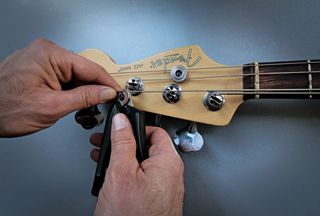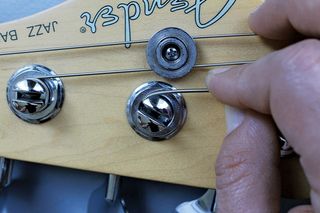How to Change Your Bass Strings

One of the perks of being a bass player is that our strings enjoy a longer lifespan than guitar strings.
As bass strings rarely break, we can go months, even years, between changing them, if we choose. Indeed, the late Motown legend James Jamerson was known for never changing his old heavy-gauge LaBella flatwounds throughout his career; he insisted that removing the “funk”—literally the grime and other accumulated mojo from years of touring and session work—would cost him his tone.
However appropriate that approach was to the soul and r&b music of the time, many of today’s players opt for a brighter, more overtone-rich sound that can jump out of a mix or punch through layers of heavy guitars, and while there’s nothing like the zing of a freshly installed set of strings, they’ll eventually start to lose high end and sustain.
This can be remedied with aggressive EQ, but with time, you’ll get to a point where even that’s not enough. Personally, I change my bass strings once a year, as older ones—at least in my hands—do break, especially when you’re hitting them aggressively to keep up with the loud guitar player or drummer in your band. This yearly preventative measure helps me feel safe at gigs while also giving me a tone boost, but everyone has a different comfort level where that’s concerned. So, for whenever you feel it’s time for a change, here are a few tips. First, determine what gauge (thickness) you want.
Generally speaking, lighter-gauge strings are easier on the fingers, while heavier-gauge strings will give you a bigger, richer tone. If the gauges of the new set are radically different from the ones you’re replacing, be sure your bass is set up to accommodate it, in terms of the neck and action.
Eons ago, as a kid making one of my first recordings, I replaced my medium-gauge strings with a set of super-lights for the fast metal song I was about to record with my friend Mike, because dammit, these strings were going to help me shred like Billy Sheehan! I quickly put them on without trying out the bass afterward, jumped in my car and drove to Mike’s studio. I eagerly pulled out my newly armed weapon only to discover that the strings had collapsed flush against the fretboard; I had inadvertently relaxed the tension in the neck by replacing heavier strings with lighter ones, which have less pull.
Fortunately, Mike, besides being an Yngwie-caliber shredder, was also a guitar tech, and he performed a proper setup to accommodate the new gauge, after appropriately scolding me for my rookie mistake. I still couldn’t shred like Billy Sheehan, but that’s not the strings’ fault. While a medium four-string set (typically .045–.105) is all-purpose and offers great bang-for-the-buck, many mix-and-match options are available.
On one of my basses, I use thicker gauges on the lower strings, for strong bottom end, and lighter gauges on the higher strings, so that I can get a little more edge when I play in the upper register. Next, remove and replace the old strings one at a time, as removing all of them at once can cause the neck to “relax,” resulting in buzzing or string height issues, as described earlier.
After removing the old string (it doesn’t matter which one you start with), thread the new string through the bridge to the ball end, pull the string tight past the nut, then mark off about an inch and a half past the string’s tuning post and cut off the remainder with wire clippers (see PHOTO A).

Insert the top of the string into the tuning post by bending it sharply around it (PHOTO B) ...

... then tune it up to pitch while pulling the rest of the string down with your free hand to keep it stable until the string is sitting on the bass securely (PHOTO C), then repeat the whole process with the remaining strings.

At this point, the strings still need to settle. Grab each string near the 12th fret and firmly stretch it from side to side a few times, but not so aggressively that you actually break the string (see PHOTO D).

The open-string pitch will now be flat; tune it back up and repeat this step sev- eral times as needed, until the string stays in tune, and you’re good to go!

Thank you for reading 5 articles this month**
Join now for unlimited access
US pricing $3.99 per month or $39.00 per year
UK pricing £2.99 per month or £29.00 per year
Europe pricing €3.49 per month or €34.00 per year
*Read 5 free articles per month without a subscription
Get The Pick Newsletter
All the latest guitar news, interviews, lessons, reviews, deals and more, direct to your inbox!

He is the fearless, Strat-wielding counterpart to icons like Pat Metheny, John Scofield and Allan Holdsworth – here’s how Wayne Krantz forged his raw, rhythmic approach to fusion guitar

“He had one of the greatest finger vibratos of all time”: Jared James Nichols on the guitar genius of Free’s Paul Kossoff
Most Popular








